




OUR BEST EVER OFFER - SAVE £100/$100
JOIN THE WORLD'S LEADING PROFESSIONAL DEVELOPMENT PROGRAMME
- 12 months membership of Elite Soccer
- Print copy of Elite Player & Coach Development
- Print copy of The Training Ground
You are viewing 1 of your 1 free articles
Dealing with crosses
Get your players dealing with crosses that are played both into and outside of the 18-yard box. Heading, clearances, blocks and communication are the key areas of focus in this session.
| Area | Use of a half-pitch |
| Equipment | Balls, cones, goals, mannequins |
| No. of Players | Full squad |
| Session Time | Defensive practice 10mins, 2v1s 10mins, Small-sided game 20mins |
This is a session that looks at defending the goal from crosses (and will often run alongside a specific session for our forward players). It involves heading and distribution outside the area, while heading, clearances, blocks and communication are the big ‘wants’ from inside the 18-yard box when defending from crosses and shots.
The session then moves onto a more opposed practice but with the same themes, with a high tempo leading this from the front, then with the introduction of more attackers, so that players have more variables, just as they would do in a game.
To that end there is no need to keep stopping play – it’s real, with game-like situations, where the players are able to practise with repetition.
We will run this practice on a weekly or fortnightly basis. It’s physical, so may be difficult to do if we have a run of matches, but it’s important for players to keep their familiarity with one another within the defensive unit – for the goalkeeper to develop an understanding with his two centre-backs, forming a strong triangle.
We’ll also manipulate the session so that players deal with an upcoming threat, and by that I mean organising the opposition players is vital in order to get them to do what you think an upcoming side will do at the weekend.
What do I get the players to do?
Defensive practice
We set up as shown, with a sequence of crosses being sent into the box to be defended (1a). We will run this practice for 10mins to see how defenders are responding to the threats that come in. When a cross is successfully defended the coach will release another ball in quickly, also aiming to vary play by feeding left and right crossers (1b/1c).
1a
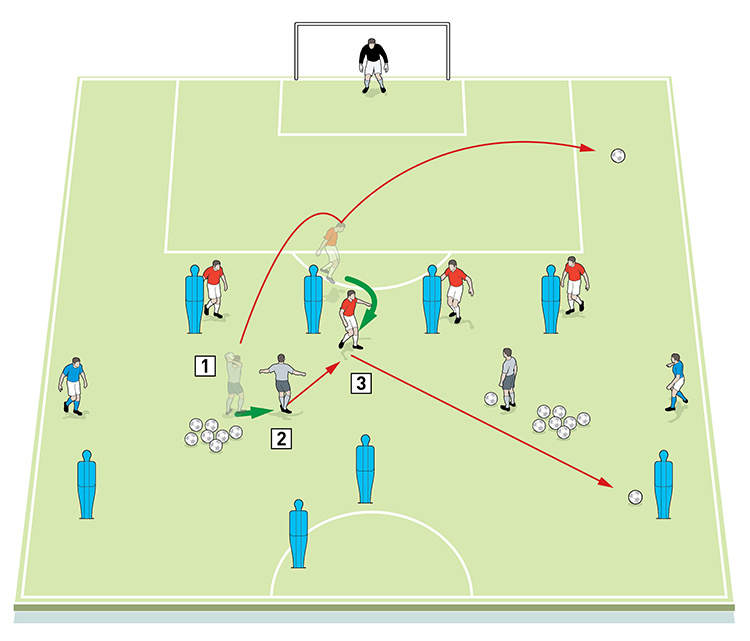
2. Now the server plays another ball to him to nip in front of the mannequin
3. The defender drives out with the ball and tries to hit one of the mannequins with a pass
1b

5. A 1v1 takes place between the full-back and wide player
6. The back four reacts and defends the cross/shot
1c
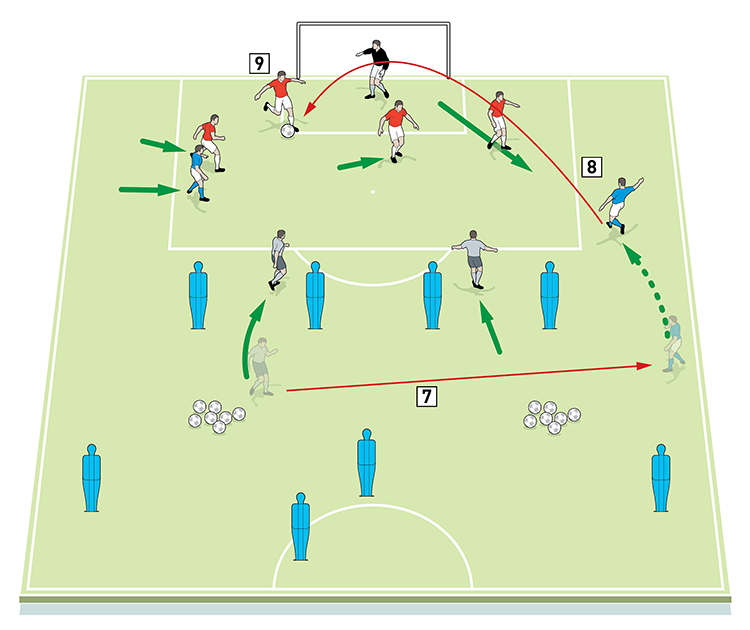
8. The wide man drives forward and crosses
9. The back four now have to react to the new crossed ball
As an easy initial progression, if the ball is cleared out of the box from a cross, the server can react and try to score with a shot. The defenders must be quick in regrouping and blocking the shot.
What are the key things to look out for?
We’re looking for clever start positions, communication, height and distance with clearances and good body shape. We want to keep the ball heading in one direction only – away from our goal! – so it’s better to defend the cross than let a wide player come inside and shoot.
When defending the cross we will always want to keep three defenders across the width of the goal. We want each of them to show aggression, to win both the first and second ball, and to make contact with attacking players before the cross comes in. We must remind players: it’s the man who scores, not the space!
2v1s
The progression sees us move play into the opposed ‘attack versus defence’ practice, with the attacking players having an overload (2a).
2a
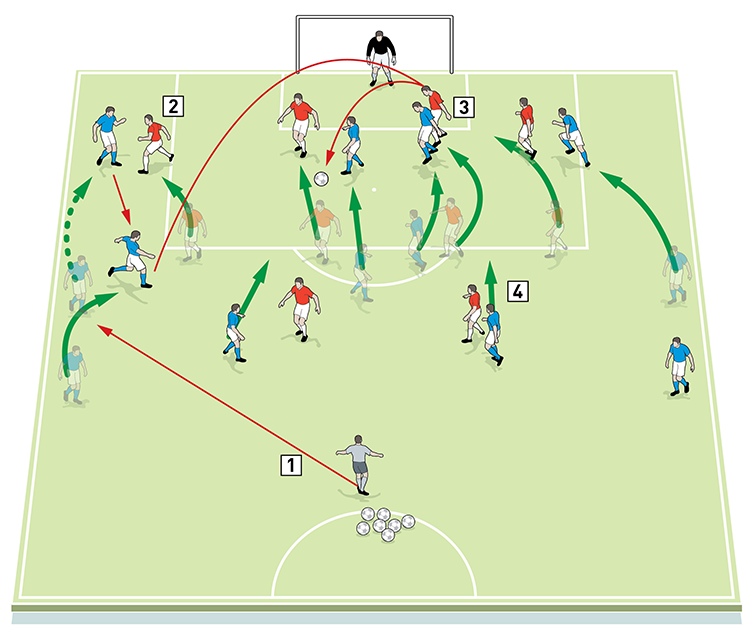
2. The full-back moves in to try to defend against the 2v1
3. Now two strikers and the opposite wide player move into the box to attack the cross
4. The two attacking midfielders on the edge of the box (as servers were in the previous practice) are there to latch onto anything that is half-cleared
In this second practice, one of the defensive midfield players can get out to help the full-backs (in the same way that Nemanja Matic does for Chelsea) while the other gets into a position in the centre of the pitch five or six yards higher than the back four (2b).
2b
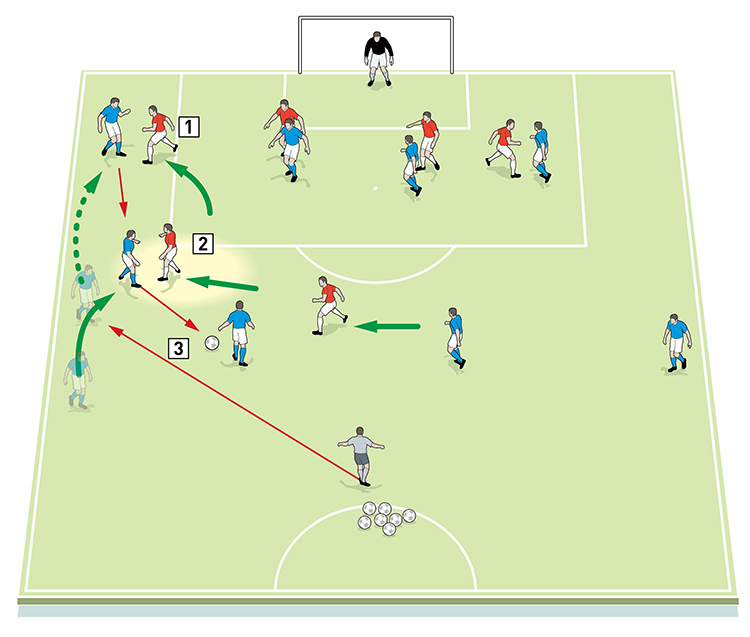
2. The holding midfield player moves across to support the full-back
3. The Blues are forced to pass backwards and the attack is nullified
Again, we will run this as a sequence of crosses, on each one recommending ideas and revisions based on the technical and tactical decisions our defenders make.
What are the key things to look out for?
One of the key mistakes is that players can often ‘close’ themselves off when defending crosses, not allowing them to see man and ball. It’s imperative they find space to view any incoming threat.
We must also protect against rash clearances. Instead, we want players to relax and use a big surface in getting height and distance to clearances.
And as I already noted, we’ll always remind players: ‘space doesn’t score goals, players do!’ So we want them to get body contact in at every opportunity. That doesn’t mean fouling an opponent, but we want them to be physical and clever in doing whatever’s necessary to put an opponent off.
Small-sided game
We will often wrap up with a game situation, as shown (3), using four defensive midfield players but with blues conditioned to send the ball wide before it can be crossed in.
3
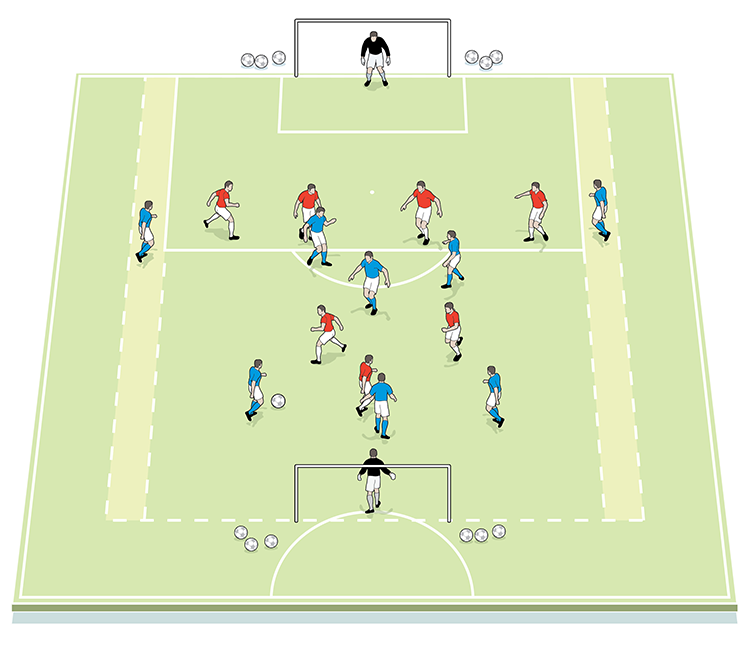
Related Files
Editor's Picks
Attacking transitions
Deep runs in the final third
Using the goalkeeper in build-up play
Intensive boxes drill with goals
Penetrating the final third
Creating and finishing
My philosophy
Pressing initiation
Compact team movement
Coaches' Testimonials

Alan Pardew

Arsène Wenger

Brendan Rodgers

Carlos Carvalhal

José Mourinho

Jürgen Klopp

Pep Guardiola

Roy Hodgson

Sir Alex Ferguson

Steven Gerrard
Related
Coaches' Testimonials

Gerald Kearney, Downtown Las Vegas Soccer Club

Paul Butler, Florida, USA

Rick Shields, Springboro, USA

Tony Green, Pierrefonds Titans, Quebec, Canada
Join the world's leading coaches and managers and discover for yourself one of the best kept secrets in coaching. No other training tool on the planet is written or read by the calibre of names you’ll find in Elite Soccer.
In a recent survey 92% of subscribers said Elite Soccer makes them more confident, 89% said it makes them a more effective coach and 91% said it makes them more inspired.
Get Monthly Inspiration
All the latest techniques and approaches
Since 2010 Elite Soccer has given subscribers exclusive insight into the training ground practices of the world’s best coaches. Published in partnership with the League Managers Association we have unparalleled access to the leading lights in the English leagues, as well as a host of international managers.
Elite Soccer exclusively features sessions written by the coaches themselves. There are no observed sessions and no sessions “in the style of”, just first-hand advice delivered direct to you from the coach.






